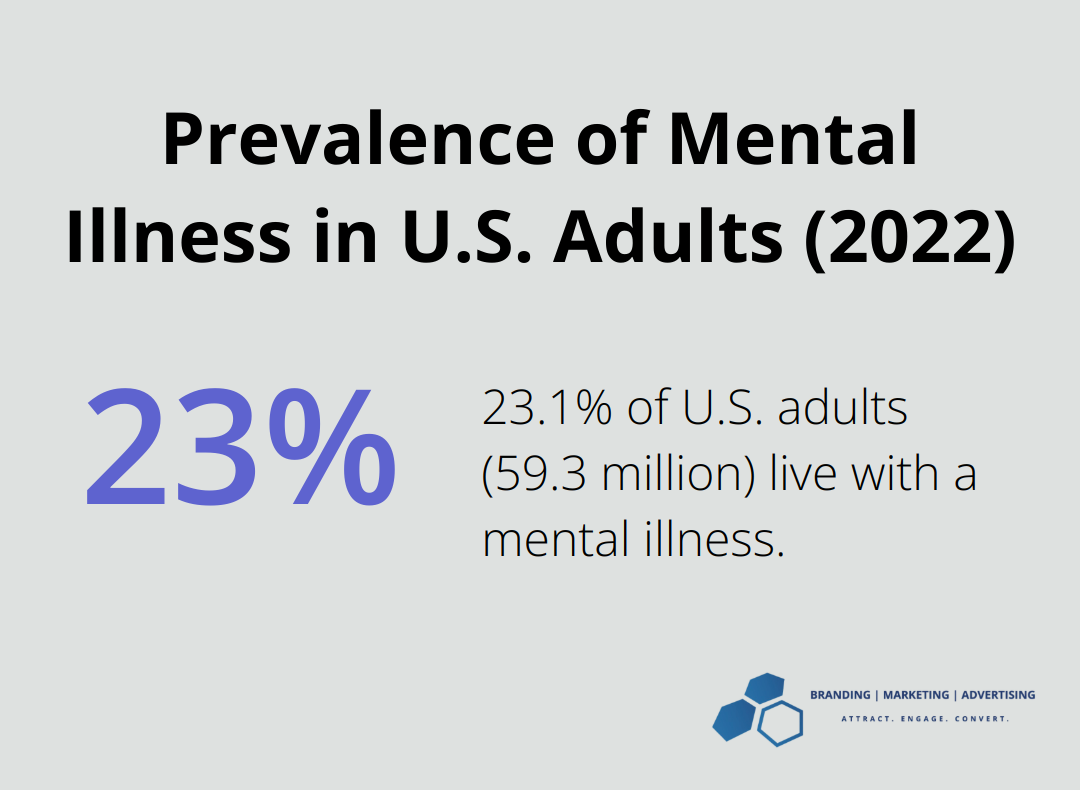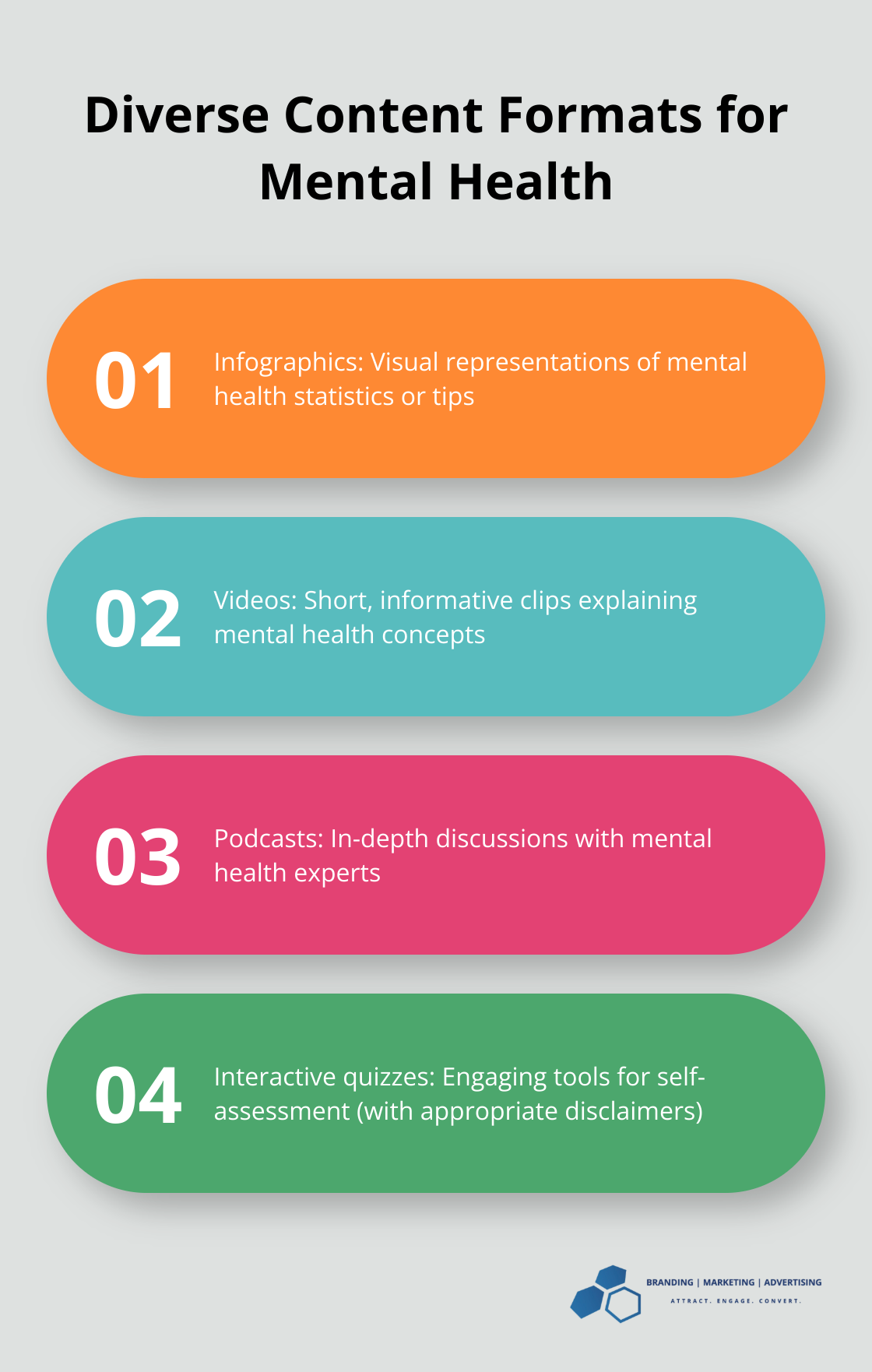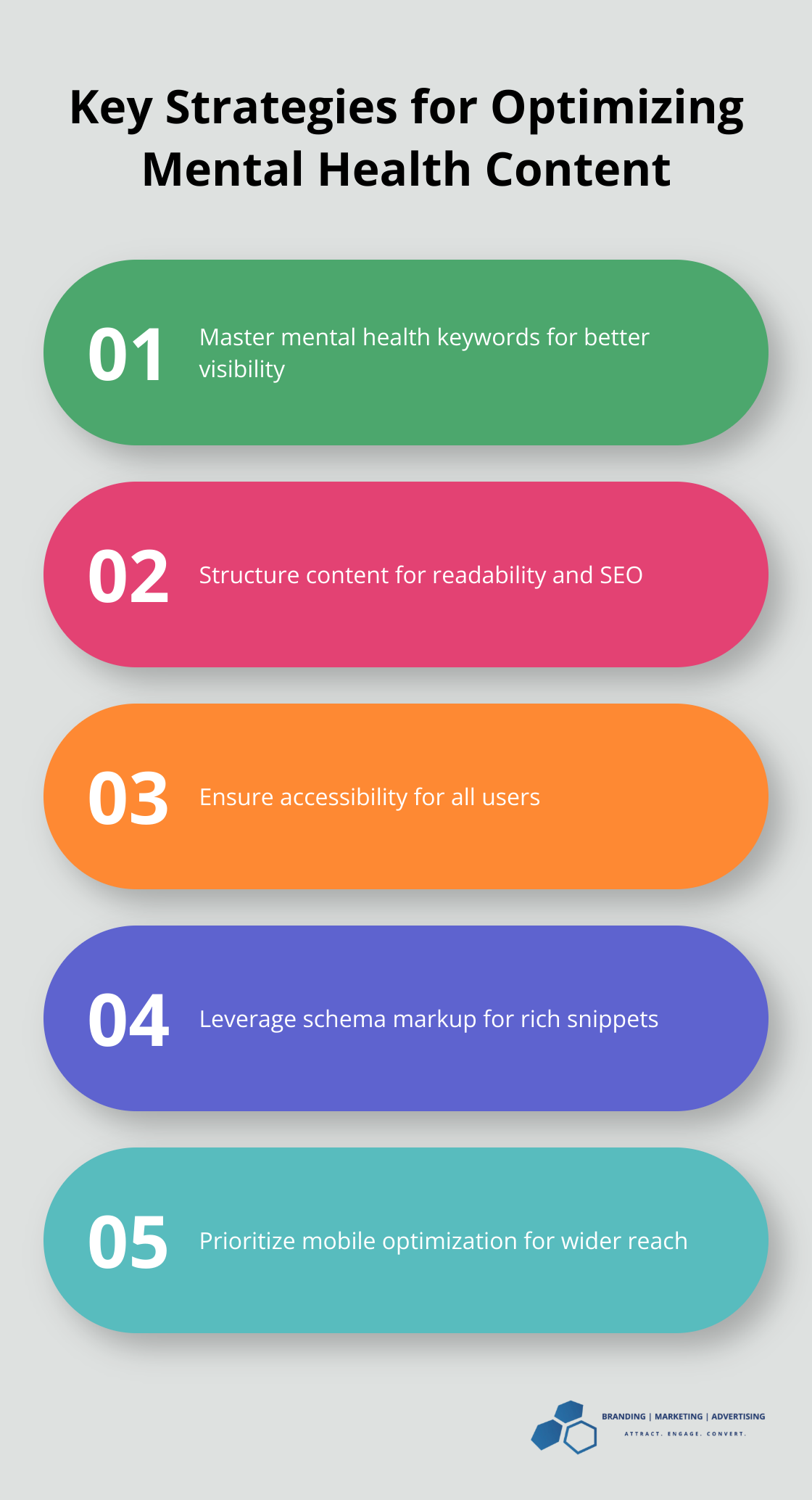Creating Valuable Content for Mental Health Audiences
Mental health content has become increasingly important in today’s digital landscape. At Branding | Marketing | Advertising, we understand the power of well-crafted information to support and empower those seeking mental health resources.
Our blog post explores strategies for creating valuable content that resonates with mental health audiences. We’ll guide you through understanding your target audience, crafting engaging material, and optimizing your content for maximum reach and impact.
Who Are Your Mental Health Readers
Defining Your Target Audience
Understanding your mental health audience forms the foundation of creating valuable content. Identifying key demographics of your readers is the first step. Are they primarily young adults struggling with anxiety, or older individuals managing depression? The National Institute of Mental Health reports that more than one in five U.S. adults live with a mental illness (59.3 million in 2022; 23.1% of the U.S. adult population), underscoring the diverse nature of mental health audiences.

Psychographics play a crucial role too. What are the values, interests, and lifestyle choices of your audience? A study by the American Psychological Association found that 48% of Gen Z reported their mental health as fair or poor. This insight can guide content creation for younger audiences.
Addressing Common Mental Health Concerns
Recognizing prevalent mental health issues among your readers is essential. The World Health Organization reports that 15% of working-age adults were estimated to have a mental disorder in 2019. Anxiety disorders are also common, impacting a significant portion of the global population.
Creating content that directly addresses these common concerns often yields success. For example, a blog post on “5 Effective Strategies for Managing Anxiety in Daily Life” can resonate strongly with audiences, demonstrating the importance of tackling widespread issues head-on.
Staying Current with Mental Health Trends
Keeping up with current mental health trends is vital. The COVID-19 pandemic led to a significant increase in anxiety and depression worldwide. This shift highlights the need for content addressing pandemic-related mental health challenges.
A growing interest in holistic approaches to mental health has also emerged. An article on “The Mind-Body Connection: How Physical Health Impacts Mental Wellbeing” can garner significant engagement, reflecting this trend.
Leveraging Data for Audience Insights
Use analytics tools to gain deeper insights into your audience. Google Analytics can reveal which topics resonate most with your readers. Social media analytics offer valuable information about engagement patterns and content preferences.
Combining these data-driven insights with empathetic understanding creates the most impactful content. A post on “Breaking the Stigma: Encouraging Open Conversations About Mental Health” developed based on audience data can prove highly effective in fostering engagement.
Adapting to Audience Needs
Your audience’s needs may evolve. Regular surveys of your readers or conducting focus groups help you stay attuned to their changing concerns. This approach allows you to adapt your content strategy proactively.
For instance, an increasing interest in workplace mental health might emerge. An article like “Fostering Mental Health in the Workplace: Strategies for Employers and Employees” can address this emerging need, potentially resulting in high readership and shares.
A thorough understanding of your mental health audience allows you to create content that not only informs but also resonates on a personal level. This connection builds trust and provides genuine value to your readers. As we move forward, let’s explore how to craft engaging and informative mental health content that speaks directly to these well-defined audiences.
How to Craft Compelling Mental Health Content
Creating engaging and informative mental health content requires a strategic approach. Here’s how you can produce content that resonates with mental health audiences and makes a real impact.
Choose Topics That Matter
Selecting relevant topics is essential. Examine current mental health trends and issues that your audience faces. Create content that addresses specific challenges. A piece on “5 Practical Ways to Manage Work-Related Stress” could be highly relevant. Or, given the rise in anxiety disorders, an article on “Understanding and Coping with Social Anxiety” could strongly resonate with your audience.
Leverage Expert Insights
Expert opinions add credibility to your content. Contact mental health professionals for quotes or insights. Leveraging Expert Insights can provide valuable content that distinguishes you from competitors.
Don’t limit yourself to external experts. If you have in-house mental health professionals, use their expertise. Their unique perspectives can provide valuable content that distinguishes you from competitors.
Tell Compelling Stories
Storytelling in mental health content is a powerful tool. Real-life stories of individuals overcoming mental health challenges can inspire and connect with readers on an emotional level. You could feature a story about someone who successfully managed their depression through a combination of therapy and lifestyle changes.
Always prioritize privacy and obtain necessary permissions when sharing personal stories. You can also use anonymized case studies to illustrate points without compromising anyone’s privacy.
Balance these stories with practical advice. After sharing a personal account, provide actionable tips that readers can apply to their own lives. This approach not only engages readers but also offers tangible value.
Use Diverse Content Formats
Diversify your content formats to cater to different learning styles and preferences. Consider creating:
- Infographics: Visual representations of mental health statistics or tips
- Videos: Short, informative clips explaining mental health concepts
- Podcasts: In-depth discussions with mental health experts
- Interactive quizzes: Engaging tools for self-assessment (with appropriate disclaimers)

This variety can help you reach a broader audience and keep your content fresh and engaging.
Maintain a Consistent Tone
Establish a consistent tone across your mental health content. Aim for a balance between professional and approachable. Your content should convey expertise while remaining accessible to a general audience. Use clear, factual language without being overly clinical or alarmist to ensure your content is easily understood.
As we move forward, let’s explore how to optimize your mental health content for search engines and accessibility, ensuring it reaches and benefits the widest possible audience.
How to Optimize Mental Health Content for Maximum Impact
Creating valuable mental health content requires strategic optimization to reach and resonate with your target audience. This chapter explores effective strategies to enhance the visibility and accessibility of your mental health content.

Master Mental Health Keywords
Keyword research plays a vital role in mental health topics. Tools like Google Keyword Planner and SEMrush reveal popular search terms. Incorporate high-volume keywords naturally into your content to boost visibility.
Don’t overlook long-tail keywords. Phrases like “how to cope with social anxiety at work” may have lower search volumes but often indicate higher intent. These make excellent targets for in-depth articles or blog posts.
Structure Content for Readability and SEO
Clear structure benefits both readers and search engines. Use descriptive headers (H2, H3) to break up your content. For instance, in an article about depression, you might use headers like “Common Symptoms of Depression” and “Treatment Options for Depression.”
Keep paragraphs short (ideally 2-3 sentences). This improves readability, especially on mobile devices. Structure your content to accommodate this behavior to improve engagement.
Include a meta description for each piece of content. This 150-160 character summary appears in search results and can significantly impact click-through rates. Make it compelling and include your primary keyword.
Ensure Accessibility for All
Accessibility extends beyond compliance – it’s about reaching everyone who needs your content. Use alt text for images to describe them for visually impaired users. (For example, an infographic about stress management techniques should have alt text describing each technique.)
Try to use a larger font size (at least 16px) and high contrast colors to improve readability. The Web Content Accessibility Guidelines (WCAG) recommend a contrast ratio of at least 4.5:1 for normal text.
Video content should include captions and transcripts. This not only helps hearing-impaired users but also improves SEO as search engines can index the text.
Leverage Schema Markup
Schema markup helps search engines understand your content better. For mental health topics, you might use the “MedicalCondition” schema to provide structured data about specific disorders. This can lead to rich snippets in search results, potentially increasing click-through rates.
Prioritize Mobile Optimization
With over 50% of global web traffic coming from mobile devices, your mental health content must be mobile-friendly. Google’s mobile-first indexing prioritizes the mobile version of your site for ranking. Ensure your content is easily readable on smaller screens and that interactive elements are touch-friendly.
These strategies can significantly enhance the reach and impact of your mental health content. Optimization is an ongoing process, so regularly review your analytics and stay updated on SEO best practices.
Final Thoughts
Creating valuable mental health content demands a thoughtful, strategic approach. We explored the importance of understanding your audience, crafting engaging material, and optimizing for reach and accessibility. These elements form the foundation of impactful mental health content that truly resonates with readers.
Empathy and authenticity are paramount when addressing mental health topics. Your content should reflect genuine understanding and compassion for those struggling with mental health challenges (this approach builds trust and encourages readers to engage more deeply with your material). The mental health landscape constantly evolves, so stay informed about new research, treatment approaches, and societal trends.
Effective mental health content has the power to educate, support, and inspire. You can create content that not only reaches your target audience but also makes a meaningful difference in their lives. At Branding | Marketing | Advertising, we help you craft impactful mental health content that drives engagement and supports your overall marketing goals.












